2022-10-3
瑞士畫家Jean-étienne Liotard(1702 - 1789)有一幅靜物粉彩,畫的是乾隆時期的中國或英國茶具,收藏在洛杉磯的蓋蒂藝術中心的博物館裡,對於研究中國外銷瓷和茶文化的人,是一個很好的佐證。
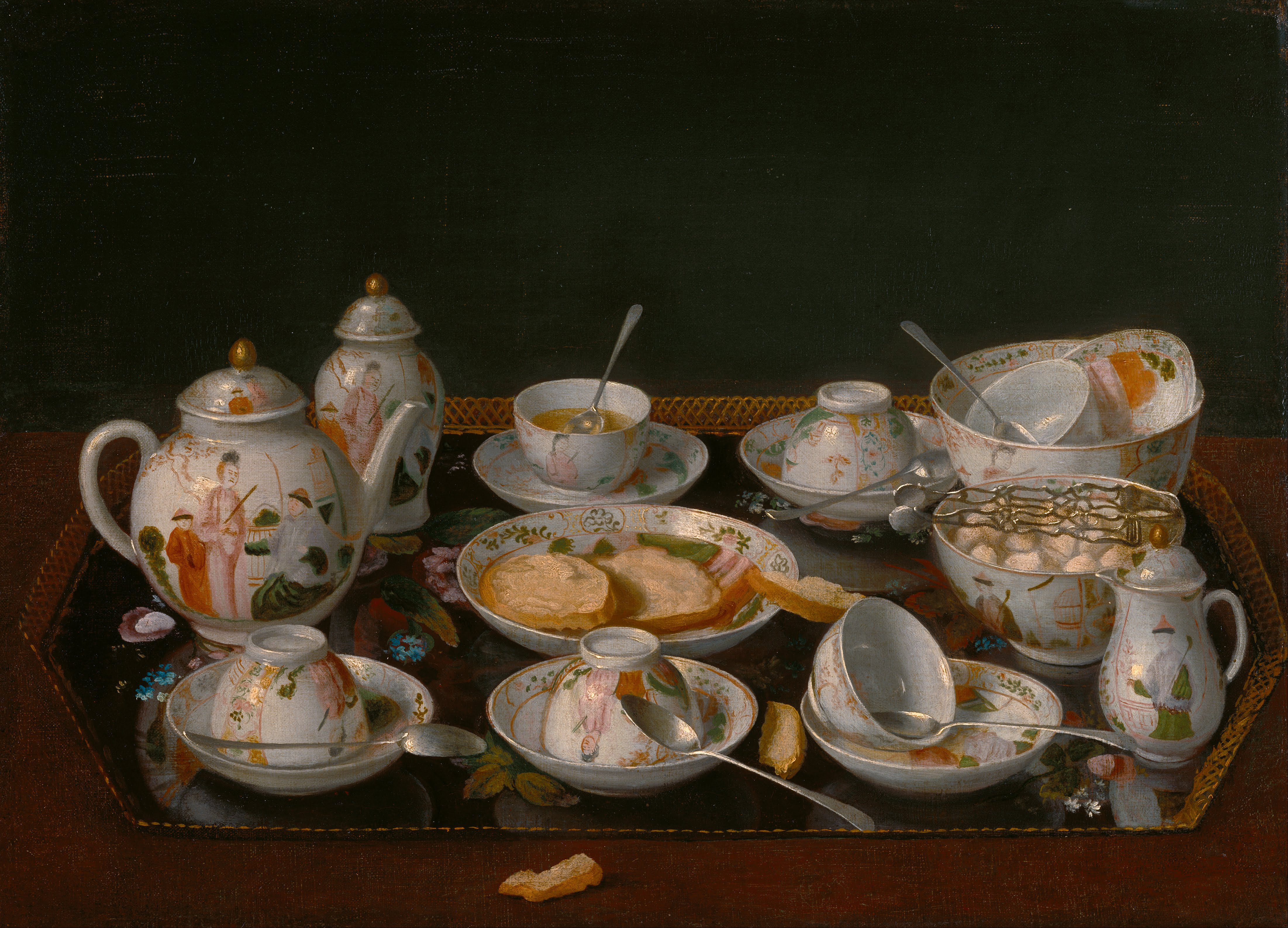
In this painting of tea-time disarray, a tray is set with six cups and saucers, a teapot, sugar bowl, milk jug, and a lidded vase perhaps containing an extra supply of tea leaves. A large bowl holding a teacup and saucer could also be used for dumping the slopes of cold tea and used tea leaves. By the time Liotard painted this work in the late 1700s, tea drinking had become fashionable among the middle as well as upper classes. Liotard contrasted the luxurious materials of Chinese porcelain and silver with a cheaper tray of painted tin, known as tôle that imitated Asian lacquer. Combining the transparent, reflective, and brightly-patterned objects allowed the artist to portray strong visual contrasts.
之所以說是英國的瓷器,因為有人做過考證,只有英國軟瓷,才有這樣的粉筆繪畫效果:
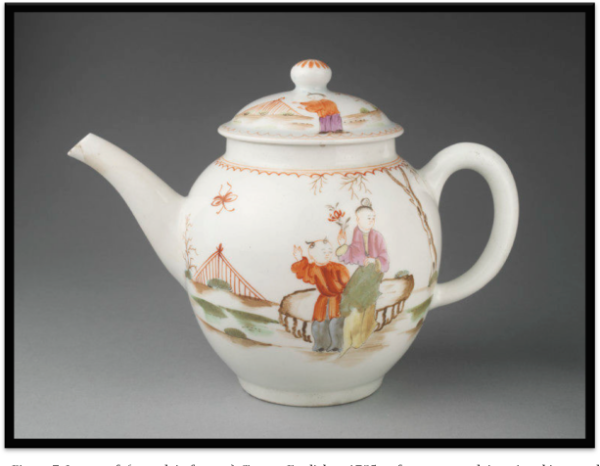
Jean-étienne Liotard創作的類似茶具咖啡具的粉彩畫,還有多幅,都是他晚年的創作:


Chinese porcelain and tea-drinking were the rages of fashionable Europe when Jean-étienne Liotard was born. He began painting tea and coffee sets in the last two decades of his life when age, changes in taste, and his political beliefs caused a decline in requests for the pastel portraits that were his specialty. He had, however, been including fruit and porcelain still lifes in some of his portraits since about 1740. Only five of his paintings of tea and coffee sets are known today.
吃早餐的荷蘭女郎(A Dutch girl at breakfast),在英國拍出了天價,目前珍藏在阿姆斯特丹博物館:
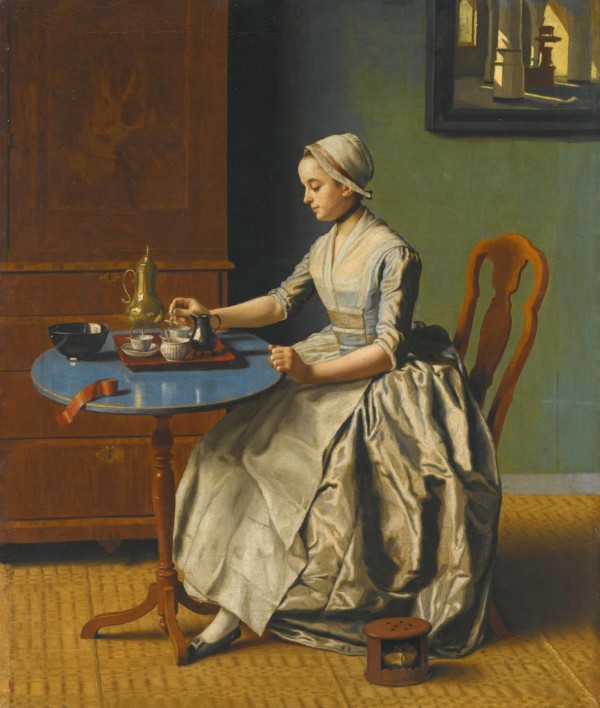
Lady Pouring Chocolate (Dutch girl at Breakfast) (1744) is an oil on canvas painting by Swiss artist, Jean-Etienne Liotard. Liotard’s subject is one of total simplicity and tranquillity. In a quiet and modest interior, a young woman sits at her ease at a tripod table, where she pours a cup of coffee from a silver pot into a porcelain cup. The girl is demurely dressed in a grey-brown and blue dress and cream pinafore, her hair tied beneath a simple white lace cap with a brown ribbon. The interior is modestly furnished with a plain wooden armoire, the floor covered with simple straw matting. Behind her on the wall hangs a Dutch 17th-century painting of a church interior. The table top is slightly tilted so that the artist can give full rein to his skill in rendering its polished blue surface and the depiction of the porcelain and silver on a red lacquer tray that comprises the coffee service. The composition is beautifully balanced, with the verticals of the armoire and chair offset by the circles formed by the tabletop, the foot warmer, and the shadow cast on the floor behind the seated girl. The overall tonality is equally serene, the diffuse light entering from the left playing over a harmonious range of earthy colors: the brown of the table and chair, the cream of the floor and pale green walls, and the white of the girl’s cap and apron, illumined by the blue accents of her dress and the table-top. Tiny passages of color, such as the red ribbon on the tabletop, or the blue ribbon around the girl’s neck, subtly underpin this harmony.
可是在Jean-étienne Liotard所有的繪畫中,有一幅更為知名,叫《巧克力女郎》(The Choclate Girl),號稱是一個女郎,溫暖了一個城市。

The Chocolate Girl (known also as La Belle Chocolatière, or Das Schokoladenmädchen) doesn’t take any notice of the viewer fully concentrating on serving the hot chocolate, which Liotard depicts almost as a chic ritual. Chocolate was a luxury drink at the time and could be afforded only by the nobility or merchants. Liotard painted The Chocolate Girl between 1743 and 1745, during his stay in Vienna at the court of the Austrian Empress Maria-Theresia. It was common back then that young pretty girls from families of lower nobility were recruited to the court as maidens or companions to princesses. While it has never been determined with certainty who was the model for this portrait, it is possible that it was one of the maidens at the court who simply impressed the artist with her beauty.
關於這幅畫作的傳說和研究,不勝枚舉:
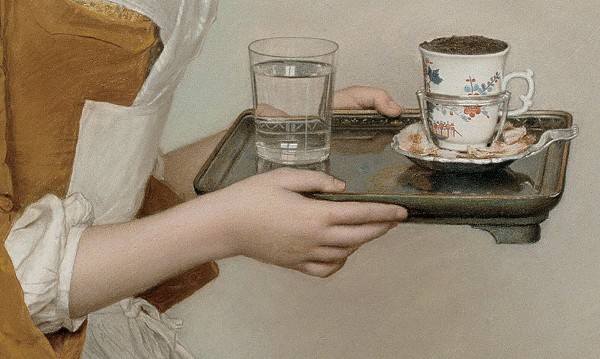
There is of course another interpretation that reads more like a fairy-tale but nevertheless offers a convincing explanation of this finely painted portrait and its subject. It is thought that the chocolate girl was a daughter of an impoverished knight Anna Balthauf, who worked in one of the chocolate shops in Vienna. One day, Prince Dietrichstein, a young Austrian nobleman visited the shop and fell in love with Anna and soon thereafter asked her to marry him. The present work could be commissioned to Liotard as a wedding gift, portraying Anna as the Prince first saw her.
這幅畫,目前珍藏在位於德國德累斯頓的歷代大師畫廊(Gemäldegalerie Alte Meister)。是德累斯頓國家藝術收藏館的一部分,以藏有藝術史上眾多大師傑作而着稱。https://www.youtube.com/watch?v=bkIJ9l1huqY
It was thanks to the art dealer Algarotti, who purchased the Chocolatière directly from the artist for the Dresden Pastellkabinett in 1745, that the Gallery began to show works by contemporary artists. The pastel medium suited the Rococo taste for lifelike, brilliant portraits: Liotard created flawless, porcelain-smooth surfaces. The enormous popularity of the picture, however, also rests on the fact that it depicts a simple, unidentified housemaid, a hitherto rare motif.
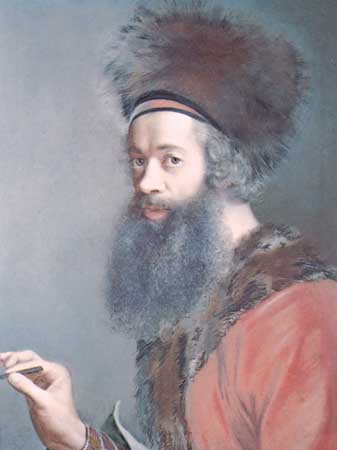
Jean-étienne Liotard(1702 - 1789)自畫像
|













